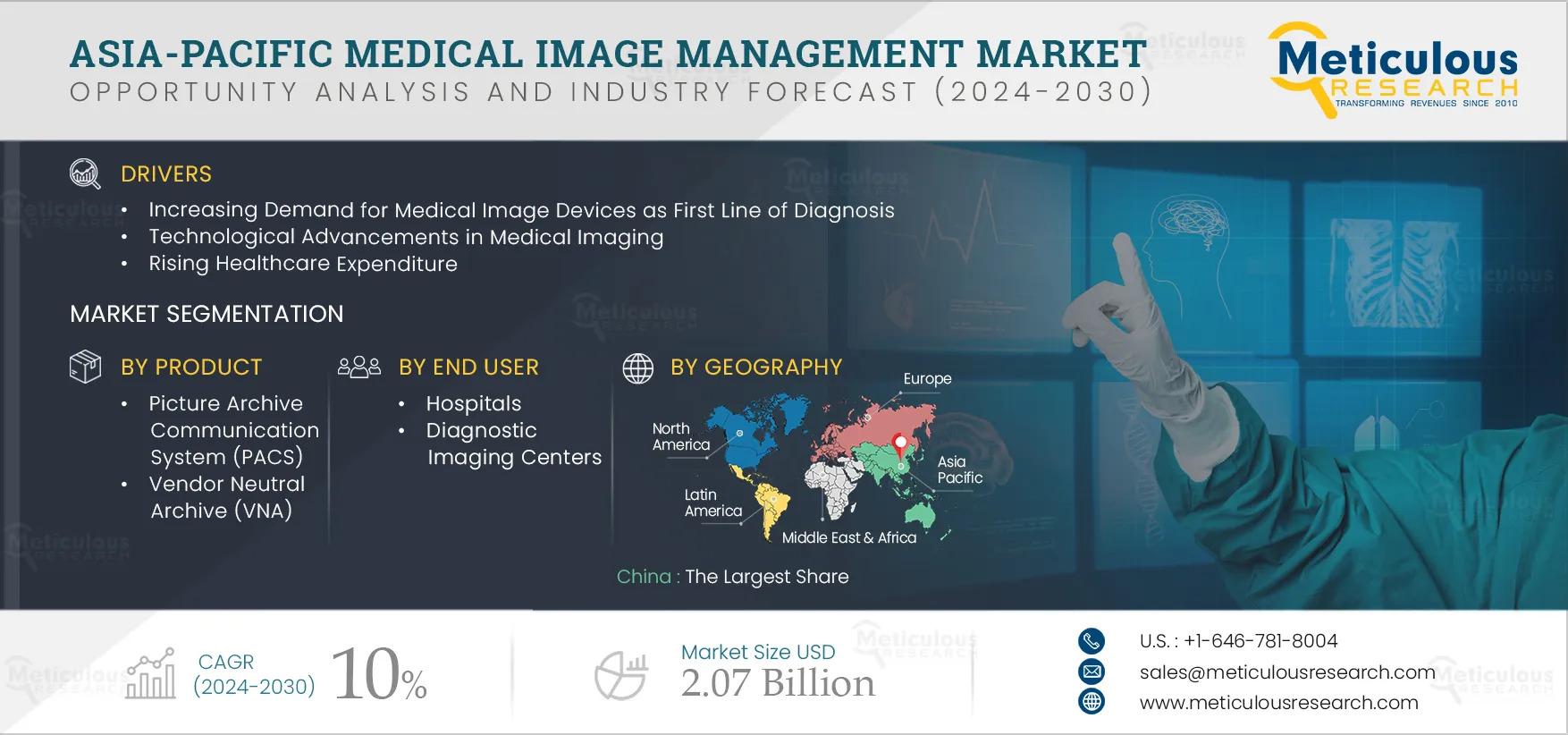Asia-Pacific Medical Image Management Market Growth & Future Trends

Asia-Pacific Medical Image Management Market: Deep-Dive Q&A for Industry Leaders and Innovators (2025–2032)
What factors are most likely to influence market growth in China?
China has a significant impact due to increased healthcare investment, a large patient population, and quick adoption of new technologies. Urbanization and strong government goals have led to the development of modern hospitals and diagnostic centers that focus on digital image management.
AI-driven radiology, telemedicine, and automated diagnostics are becoming common, aided by initiatives like "Healthy China 2030," which promotes digitization and data integration across the country. Local tech companies, collaborations with global leaders, and extensive imaging equipment deployment mean that growth in China often sets trends for the entire region.
How will cloud-based solutions impact the market's expansion prospects?
Cloud-based platforms are changing the landscape. Providers can now enjoy flexible and affordable image storage, immediate access, and easy sharing across different locations. Hybrid solutions that merge cloud and on-premise features provide hospitals with both flexibility and security.
For rural clinics and rapidly growing urban centers, the cloud removes the need for costly hardware while ensuring compliance and disaster recovery. The shift toward digital healthcare—driven by increased telehealth usage and data analysis—makes cloud PACS and VNA essential for growth, with small and mid-sized hospitals leading the way in realizing these advantages.
Why are vendor-neutral archive (VNA) solutions expected to face decline?
The demand for VNA is decreasing due to three main reasons: longer replacement cycles, high costs, and the emergence of all-in-one cloud solutions. As healthcare networks consolidate, IT managers are leaning toward platforms that combine image management with electronic medical records, analytics, and patient portals.
Additionally, advanced cloud technologies are increasingly offering interoperability features that were once the sole domain of VNA, without requiring significant investment or maintenance. Consequently, the market is shifting toward more streamlined and unified solutions, particularly among facilities with limited resources.
What role do government initiatives play in boosting market adoption?
Government support is crucial in many ways. Tax incentives for digital upgrades, funding for rural hospital connections, and new regulations for medical data handling all enhance demand. National e-health platforms and government-led pilot projects often lead to industry-wide transformation.
Clear regulations on medical data privacy and retention encourage adoption, while telemedicine and pandemic readiness programs emphasize the need for centralized, secure image management for effective healthcare delivery.
How might demographic trends shape future innovations in medical imaging?
The increasing number of elderly people and higher rates of chronic illnesses demand new imaging methods and quicker, more collaborative workflows. Hospitals and imaging centers are adapting by deploying mobile imaging vans, AI triage tools, and patient-focused cloud archives.
The emphasis is shifting to predictive imaging and integrating whole-patient data, with solutions designed for long-term care management, remote follow-up, and precise diagnostics that cater to both urban and underserved areas.
How is AI transforming image management workflows in Asia-Pacific?
AI is changing workflows in major ways. It handles tasks like automated triage and pattern recognition alongside predictive maintenance of imaging equipment and smart scheduling.
Intelligent algorithms speed up image interpretation, lessen clinician workload, and allow for earlier diagnoses, while AI-powered archiving optimizes storage use. In China and Southeast Asia, startups and established global companies are incorporating AI modules into their systems, improving efficiency and clinical value.
What are the biggest barriers to integrating image management with national health information systems?
Integration faces challenges such as data standardization, outdated IT systems, and scattered regulations. Various local vendors and healthcare practices complicate data exchange.
Leading countries in Asia-Pacific are addressing these challenges by creating unified standards (like DICOM), establishing middleware for data conversion, and offering incentives for compliance. However, continuous investment in training, software upgrades, and strong cybersecurity is necessary to close gaps and achieve seamless integration.
Which end-user sectors are leading adoption, and how is this evolving?
Hospitals are the primary adopters due to their large imaging needs, but diagnostic imaging centers and specialty clinics are quickly gaining ground. Mobile health units for rural outreach, cancer care centers, and telemedicine providers are investing in flexible management systems to meet the growing demand for remote and outpatient services.
The rise of multi-specialty clinics and international healthcare chains is also speeding up platform upgrades and innovations, driving competitive differentiation across the industry.
Conclusion:
From China's significant changes to cloud-enabled growth and new advancements in AI, the Asia-Pacific Medical Image Management Market is vibrant and full of possibilities. Whether you are a technology provider, investor, or healthcare leader, the latest report offers valuable insights and growth opportunities.
Download Sample Report Here @
https://www.meticulousresearch.com/download-sample-report/cp_id=5626
Contact Us:
Meticulous Research®
Email- sales@meticulousresearch.com
Contact Sales- +1-646-781-8004
Connect with us on LinkedIn- https://www.linkedin.com/company/meticulous-research
- Art
- Causes
- Crafts
- Dance
- Drinks
- Film
- Fitness
- Food
- Jeux
- Gardening
- Health
- Domicile
- Literature
- Music
- Networking
- Autre
- Party
- Religion
- Shopping
- Sports
- Theater
- Wellness


